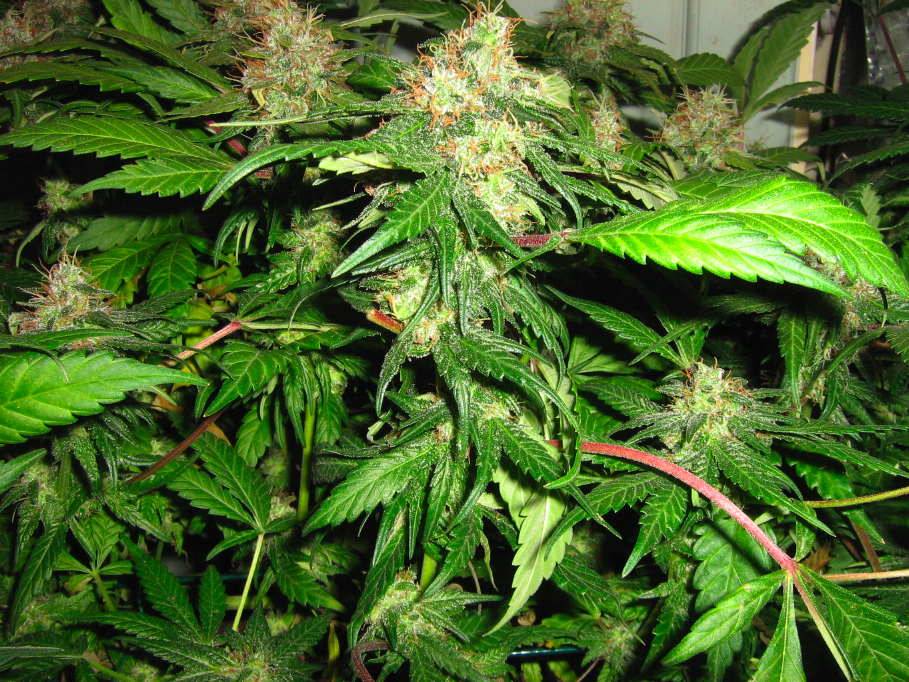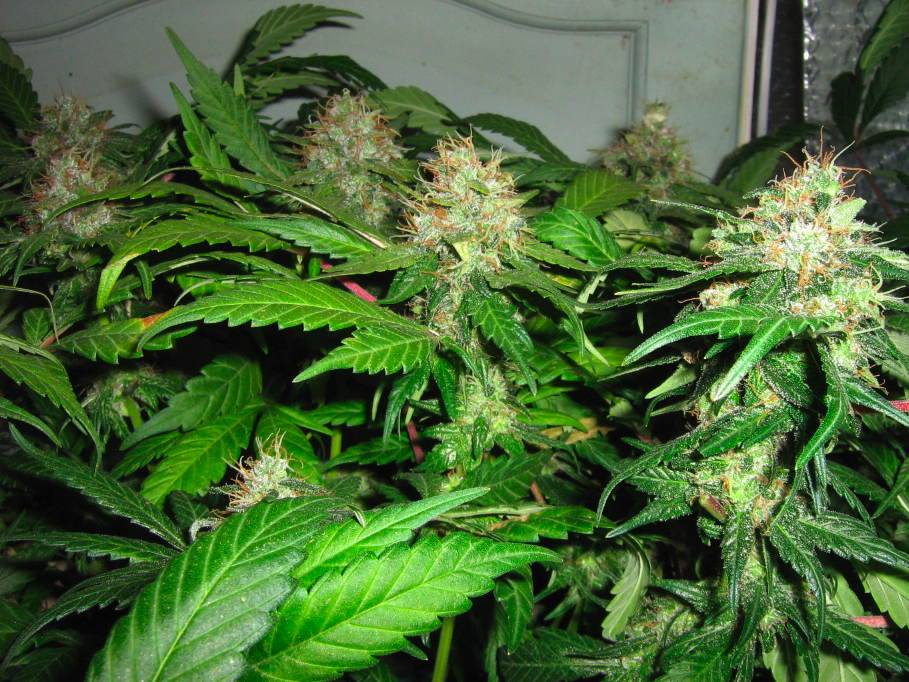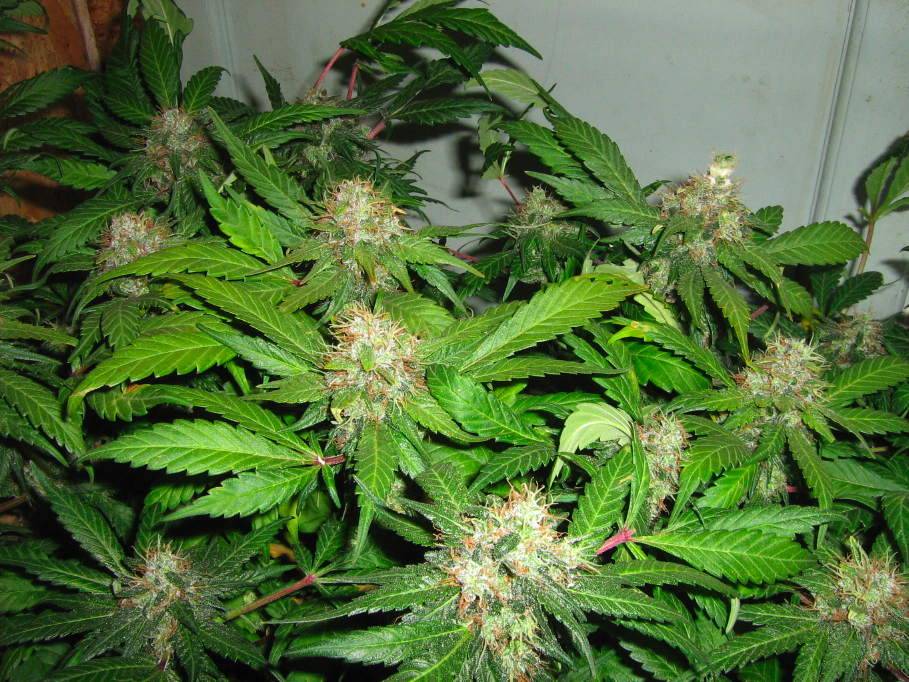You are using an out of date browser. It may not display this or other websites correctly.
You should upgrade or use an alternative browser.
You should upgrade or use an alternative browser.
VerdantGreen's 63 Watt LED Micro Cab.
- Thread starter VerdantGreen
- Start date
Amazing for a 63 watt LED!!!!Great going VG!!
Can't wait to see them when they are done..
Can't wait to see them when they are done..
Amazing for a 63 watt LED!!!!
Agreed on the light side of things. I also try to keep in mind that this is a very basic grow that just about any member on this forum could re-produce. If I remember correctly, VG's using organic soil where very little nutrients have been added during bloom, there is no CO2 enrichment, and the plant has also endured a cold spell. It's not the highest yielding strain he's ever done, and this is his first LED grow ever. Even for experienced gardeners there is a slight learning curve with LED, so with all variables considered I must say I am incredibly impressed by what VG has achieved using such a simple setup. It makes me imagine what he could do with some CO2, 85 degree constant temps, and a high yielding strain.

VG: I can't wait to see what you pull with the 205W, now that you've got some experience with LED and you know what temps to maintain. You've already impressed me with our 63W, so keep up the good work! I'm excited to see how this grow turns out in grams per watt as well. So many little head colas!

holy sheet that sheet looks so so great and so beautiful.
kaze420, b00m, BC Chronic, #1cheesebuds - thanks guys!
MeanBean - standard practice with scrog is to remove all buds and leaves below the screen to concentrate growth above and increase ventilation. i often leave some leaf below as then the plant will shed them naturally and use the nutrients that those leaves have stored
yesum - i think anything approaching 1g/watt would be very impressive for this light with this grow and strain. the MMG could at best be described as a medium yielder so 1g/watt this time could very well translate to 1.5g/watt with warmer temps and a higher yielding strain next time
as far as my research tells me its pretty hard to reach 1g/watt using wattages as low as these. i dont think anybody has got 1g/watt with 70 watt hps for instance. im no expert but i would imagine a 126 watt LED would pull more than twice what a 63watt unit would. i think its down to something called photosynthetic photon flux density - we need LEDGirl to come and explain it to us
as for quality i think it LOOKS great - and ill also be interested to smoke some. this strain is pretty good grown under hps so it'll be interesting to see if the quality changes. i am a believer that well grown outdoor weed will have much more 'depth' in the high and more psycho-activity than hps weed due to the spectrum and it is my hope that the targeted spectrum of these LED's will give slightly higher quality smoke
LEDGirl - yes its certainly been useful practice doing this grow with LED and there are changes i would make next time - mainly make sure it stays warmer
V.
MeanBean - standard practice with scrog is to remove all buds and leaves below the screen to concentrate growth above and increase ventilation. i often leave some leaf below as then the plant will shed them naturally and use the nutrients that those leaves have stored
yesum - i think anything approaching 1g/watt would be very impressive for this light with this grow and strain. the MMG could at best be described as a medium yielder so 1g/watt this time could very well translate to 1.5g/watt with warmer temps and a higher yielding strain next time
as far as my research tells me its pretty hard to reach 1g/watt using wattages as low as these. i dont think anybody has got 1g/watt with 70 watt hps for instance. im no expert but i would imagine a 126 watt LED would pull more than twice what a 63watt unit would. i think its down to something called photosynthetic photon flux density - we need LEDGirl to come and explain it to us
as for quality i think it LOOKS great - and ill also be interested to smoke some. this strain is pretty good grown under hps so it'll be interesting to see if the quality changes. i am a believer that well grown outdoor weed will have much more 'depth' in the high and more psycho-activity than hps weed due to the spectrum and it is my hope that the targeted spectrum of these LED's will give slightly higher quality smoke
LEDGirl - yes its certainly been useful practice doing this grow with LED and there are changes i would make next time - mainly make sure it stays warmer
V.
Nice grow and quite informative too. Mucho 

as far as my research tells me its pretty hard to reach 1g/watt using wattages as low as these. i dont think anybody has got 1g/watt with 70 watt hps for instance. im no expert but i would imagine a 126 watt LED would pull more than twice what a 63watt unit would. i think its down to something called photosynthetic photon flux density - we need LEDGirl to come and explain it to us
Photosynthetically Active Radiation (PAR) is the spectral range of light between 400nm-700nm, that plants are able to use for photosynthesis. This spectrum corresponds closely with the visible range of the human eye, which peaks at 555nm. PAR is usually expressed in units of micromoles, which is a measurement of the photosynthetic photon flux density of light within a square meter. Of the 3 methods most commonly used to measure light (Lumens, Lux, PAR), PAR is the most scientific way of determining a light source's ability to drive photosynthesis. It is the only measurement of light which corresponds specifically to plants.
On a cloudless day during the peak of summer, the maximum amount of photosynthetic sunlight that hits earths surface, measures approximately 2,000 micromoles per square meter. Environmental factors such as the atmosphere, seasons, clouds, and your position on the earth, affect the amount of available sunlight on any given day.
The amount of light a plant receives has a direct impact on its growth rate. Most plants tend to grow faster when available light increases, however their maximum growth rate is achieved at a substantially lower amount of sunlight than 2,000 micromoles. The point at which a plant receives more light than they can utilize, is known as the Light Saturation Point. In some instances plants have been observed growing slower when exposed to excess amounts of light, vs growing in their optimal range. For this reason, it is not advisable to supply your plants with more micromoles per meter squared, than what is optimal for their species.
From my reading, Marijuana has a LSP (light saturation point) of about 1500 micromoles, however that is based on sunlight characteristics which include a lot of green, yellow, and orange light that plants use little to none of. With LED's the # would be substantially less, as we are only targeting the peak points at which plants absorb light, not the entire spectral range from 400-700nm.
The 126W emits double the PAR output of the 63W light, but since the footprint is less than double the size of the 63W, it would provide more micromoles per square meter allowing for faster growth rates and bigger plants. Likewise the 205W supplies more micromoles per square meter than the 126W with a slightly larger coverage area. Adding multiple lights into a small area increases this value even more so, giving you plenty of different ways that you can configure your garden to achieve the optimal growth rate. Achieving 1 gram per watt with such a low amount of PPFD as supplied by the 63W, would be outstanding! If anyone can pull it off, I'm sure it will be you VG

thehappyguy
Member
mind blown with good informationPhotosynthetically Active Radiation (PAR) is the spectral range of light between 400nm-700nm, that plants are able to use for photosynthesis. This spectrum corresponds closely with the visible range of the human eye, which peaks at 555nm. PAR is usually expressed in units of micromoles, which is a measurement of the photosynthetic photon flux density of light within a square meter. Of the 3 methods most commonly used to measure light (Lumens, Lux, PAR), PAR is the most scientific way of determining a light source's ability to drive photosynthesis. It is the only measurement of light which corresponds specifically to plants.
On a cloudless day during the peak of summer, the maximum amount of photosynthetic sunlight that hits earths surface, measures approximately 2,000 micromoles per square meter. Environmental factors such as the atmosphere, seasons, clouds, and your position on the earth, affect the amount of available sunlight on any given day.
The amount of light a plant receives has a direct impact on its growth rate. Most plants tend to grow faster when available light increases, however their maximum growth rate is achieved at a substantially lower amount of sunlight than 2,000 micromoles. The point at which a plant receives more light than they can utilize, is known as the Light Saturation Point. In some instances plants have been observed growing slower when exposed to excess amounts of light, vs growing in their optimal range. For this reason, it is not advisable to supply your plants with more micromoles per meter squared, than what is optimal for their species.
From my reading, Marijuana has a LSP (light saturation point) of about 1500 micromoles, however that is based on sunlight characteristics which include a lot of green, yellow, and orange light that plants use little to none of. With LED's the # would be substantially less, as we are only targeting the peak points at which plants absorb light, not the entire spectral range from 400-700nm.
The 126W emits double the PAR output of the 63W light, but since the footprint is less than double the size of the 63W, it would provide more micromoles per square meter allowing for faster growth rates and bigger plants. Likewise the 205W supplies more micromoles per square meter than the 126W with a slightly larger coverage area. Adding multiple lights into a small area increases this value even more so, giving you plenty of different ways that you can configure your garden to achieve the optimal growth rate. Achieving 1 gram per watt with such a low amount of PPFD as supplied by the 63W, would be outstanding! If anyone can pull it off, I'm sure it will be you VG
+rep
Marijuanasaur
Member
How often did you have to replace the bulb on your 250w HPS?
Just curious how that compares to the 275$ unit replacement on these every 6 years or so.
Just curious how that compares to the 275$ unit replacement on these every 6 years or so.
JuniorBalls
Member
LEDgirl, thanks for the wonderfully informative post!


LEDGirl - thanks for the great post! - i love it when you talk tech to me 
Marijuanasaur - hid bulbs need replacing at least once a year if you use them 12/12 for flowering. as i said before its not really a proper comparison between a 250 HPS and this 63watt LED. if you are looking for a 250 replacement i would say you should look at the 126 watt units - and it half the power usage your main ongiong saving will be on electricty (as well as new bulbs)
after a few waterings of very week molasses i have today gone back to water for the last couple of weeks or however long is left. the leaves are still dark green so there is plenty of food still stored in them if the plant needs it. nearly there now...
V.
Marijuanasaur - hid bulbs need replacing at least once a year if you use them 12/12 for flowering. as i said before its not really a proper comparison between a 250 HPS and this 63watt LED. if you are looking for a 250 replacement i would say you should look at the 126 watt units - and it half the power usage your main ongiong saving will be on electricty (as well as new bulbs)
after a few waterings of very week molasses i have today gone back to water for the last couple of weeks or however long is left. the leaves are still dark green so there is plenty of food still stored in them if the plant needs it. nearly there now...
V.
right, 9 weeks today, and the plant is starting to show some signs of finishing. the leaves are getting a little lighter and some are starting to yellow (this is what i like to see towards the end of an Organic grow) it'll be time to get the lens out soon and look at the trics
no pics today as camera run out.
V.
no pics today as camera run out.
V.
ooo wee cant wate to see them pix.
Marijuanasaur
Member
I can't wait to see yield and smoke report. sounds delightful.
StonedSoul-dier
New member
Wow!! VG im super impressed with the capabilities of these LED's. I love seeing the future of growing, and what better place than IC. Cant wait to see how these plants finish off.
p.s. congrats on the contest win.
much love.
p.s. congrats on the contest win.
much love.
#1cheesebuds, Marijuanasaur, b00m, StonedSoul-dier, yosun - thanks for the support!
managed to grab a few snaps today - day 65 - im thinking i will chop this in a week, next tuesday - if the trics look right. it's still putting on weight and the leaves are fading a little which is how i like it. i would say it looks frostier than i remember it under 250hps too.



V.
managed to grab a few snaps today - day 65 - im thinking i will chop this in a week, next tuesday - if the trics look right. it's still putting on weight and the leaves are fading a little which is how i like it. i would say it looks frostier than i remember it under 250hps too.
V.


